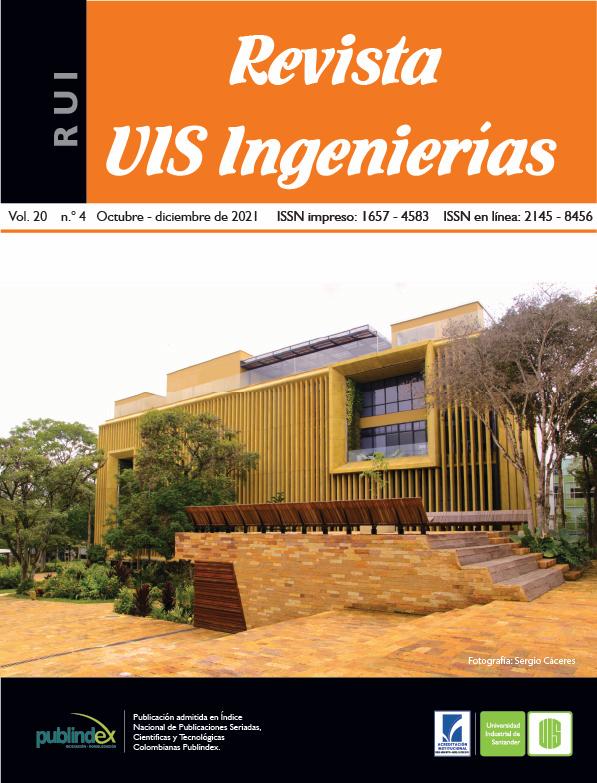Study and simulation of a gasifier with CO2 capture for the production of blue hydrogen starting from Colombian coal
Published 2021-07-16
Keywords
- coal,
- hydrogen,
- syngas,
- gasification,
- carbon dioxide
- Colombian coal,
- Aspen HYSYS,
- anthracitic,
- bituminous ...More
How to Cite
Abstract
In this research, the design and simulation of a carbon gasifier with carbon dioxide capture to obtain hydrogen was carried out using Aspen HYSYS version 9.0 software. For this study, it was used anthracitic and bituminous coal as raw material from different regions of Colombia. The characteristics of the coal, as well as the conditions of the other feed streams to the reactor, affect the final conditions of the product gas in the simulation. Once the sensitivity analysis started in the simulator, it was possible to observe the behavior of these variables, that were the feeding conditions, where the operation intervals for the process could be set. These results obtained are theoretically feasible and can be used as a basis for real cases in the energy industry since Colombia currently has one of the largest coal reserves in Latin America.
Downloads
References
[2] R. A. Huggins, Energy storage, 2nd ed. New York, NY, USA: Springer, 2010.
[3] S. Dutta, “A review on production, storage of hydrogen and its utilization as an energy resource”, Journal of Industrial and Engineering Chemistry, vol. 20, no. 4, pp. 1148-1156, 2014, doi: 10.1016/j.jiec.2013.07.037.
[4] R. B. Gupta, Hydrogen fuel: production, transport, and storage. Boca Raton, FL, USA: Crc Press, 2008.
[5] E. E. S. Michaelides, Alternative energy sources. Fort Worth, TX, USA: Springer Science & Business Media, 2012.
[6] F. Dawood, M. Anda, G. M. Shafiullah, “Hydrogen production for energy: An overview”, International Journal of Hydrogen Energy, vol. 45, no. 7, pp. 3847-3869, 2020, doi: 10.1016/j.ijhydene.2019.12.059.
[7] L. Cao et al., “Biorenewable hydrogen production through biomass gasification: A review and future prospects”, Environmental research, vol. 186, pp. 109547, 2020, doi: 10.1016/j.envres.2020.109547.
[8] H. Ju, S. Badwal, S. Giddey, “A comprehensive review of carbon and hydrocarbon assisted water electrolysis for hydrogen production”, Applied Energy, vol. 231, pp. 502-533, 2018, doi: 10.1016/j.apenergy.2018.09.125.
[9] H. Lin et al., “CO2-selective membranes for hydrogen production and CO2 capture–Part I: Membrane development”, Journal of membrane science, vol. 457, pp. 149-161, 2014, doi: 10.1016/j.memsci.2014.01.020.
[10] M. Voldsund, K. Jordal, R. Anantharaman. “Hydrogen production with CO2 capture”, International Journal of Hydrogen Energy, vol. 41, no. 9, pp. 4969-4992, 2016, doi: 10.1016/j.ijhydene.2016.01.009.
[11] N. V. Gnanapragasam, B. V. Reddy, M. A. Rosen, “Hydrogen production from coal gasification for effective downstream CO2 capture”, International Journal of Hydrogen Energy, vol. 35, no. 10, pp. 4933-4943, 2010, doi: 10.1016/j.ijhydene.2009.07.114.
[12] A. Boretti, “Production of hydrogen for export from wind and solar energy, natural gas, and coal in Australia”, International Journal of Hydrogen Energy, vol. 45, no. 7, pp. 3899-3904, 2020, doi: 10.1016/j.ijhydene.2019.12.080.
[13] T. R. Paul, H. Nath, V. Chauhan, A. Sahoo, “Gasification studies of high ash Indian coals using Aspen plus simulation”, Materials Today: Proceedings, 2020, doi: 10.1016/j.matpr.2020.04.033.
[14] T. R. Cruzado Urbina, L. M. García Rodríguez, “Diseño y simulación de un gasificador para el aprovechamiento de las reservas de carbón del alto chicama”, trabajo de grado, Universidad Nacional de Trujillo, 2017.
[15] R. B. Zapata, J. F. P. Bayer, C. S. Jiménez, “Carbones colombianos: clasificación y caracterización termoquímica para aplicaciones energéticas”, Revista ION, vol. 27, no. 2, pp. 43-54, 2014.
[16] L. J. M. Umaña, El carbón: origen, atributos, extracción y usos actuales en Colombia. Bogotá, Colombia: Universidad Nacional de Colombia, 2014.
[17] American Society for Testing and Materials (ASTM), Standard Classification of Coals by Rank, ASTM D388-12, 2012.
[18] J. F. P. Bayer, R. B. Zapata, C. S. Jiménez, Producción de gas natural sintético mediante gasificación de carbones colombianos: análisis termodinámico con Aspen Plus®. Colombia: Editorial Universidad de Antioquia, 2015.
[19] J. G. Speight, Handbook of coal analysis, 2nd ed. USA: John Wiley and Sons, 2015.
[20] U. D. UPME, “La cadena del carbón”, Ministerio de Minas y Energía, 2012 [En línea]. Disponible en: https://www.upme.gov.co/Docs/Cadena_carbon.pdf.
[21] IEA-International Energy Agency, “Key Coal Trends, Excerpt from: Coal information”, 2016 [En línea]. Disponible en: https://euagenda.eu/upload/publications/untitled-69166-ea.pdf .
[22] A. Cardoso, “Valuation languages along the coal chain from Colombia to the Netherlands and to Turkey”, Ecological Economics, vol. 146, pp. 44-59, 2018, doi: 10.1016/j.ecolecon.2017.09.012.
[23] J. Davison, S. Arienti, P. Cotone, L. Mancuso, “Co-production of hydrogen and electricity with CO2 capture”, International Journal of Greenhouse Gas Control, vol. 4, no. 2, pp. 125-130, 2010, doi: 10.1016/j.ijggc.2009.10.007.
[24] D. Osborne, The Coal Handbook: Towards Cleaner Production: Volume 2: Coal Utilisation. India: Elsevier, 2013.
[25] D. A. Bell, B. F. Towler, y M. Fan, Coal gasification and its applications. Great Britain: William Andrew, 2010.
[26] I. C. López, C. R. Ward, “Composition and mode of occurrence of mineral matter in some Colombian coals”, International Journal of Coal Geology, vol. 73, no. 1, pp. 3-18, 2008, doi: 10.1016/j.coal.2007.03.005.
[27] H. Watanabe, R. Kurose, “Modeling and simulation of coal gasification on an entrained flow coal gasifier”, Advanced Powder Technology, vol. 31, no. 7, pp. 2733-2741, 2020, doi: 10.1016/j.apt.2020.05.002.
[28] Z. Dai, R. D. Noble, D. L. Gin, X. Zhang, L. Deng, “Combination of ionic liquids with membrane technology: A new approach for CO2 separation”, Journal of Membrane Science, vol. 497, pp. 1-20, 2016, doi: 10.1016/j.memsci.2015.08.060.
[29] T. A. Peters et al., “Palladium (Pd) membranes as key enabling technology for pre-combustion CO2 capture and hydrogen production”, Energy Procedia, vol. 114, pp. 37-45, 2017, doi: 10.1016/j.egypro.2017.03.1144.
[30] M. Gazzani, G. Manzolini, “Using palladium membranes for carbon capture in integrated gasification combined cycle (IGCC) power plants”, en Palladium Membr. Technol. Hydrog. Prod. Carbon Capture Other Appl. Princ. Energy Prod. Other Appl., United Kingdom: Elsevier, 2014.2014, pp. 221-246.
[31] AspenTech, Aspen HYSYS Help Section, Aspen Technology, Inc., Burlington, MA, USA: 2011.
[32] C. F. Palma, A. D. Martin, “Model based evaluation of six energy integration schemes applied to a small-scale gasification process for power generation”, Biomass and Bioenergy, vol. 54, pp. 201-210, 2013, doi: 10.1016/j.biombioe.2013.03.024.


